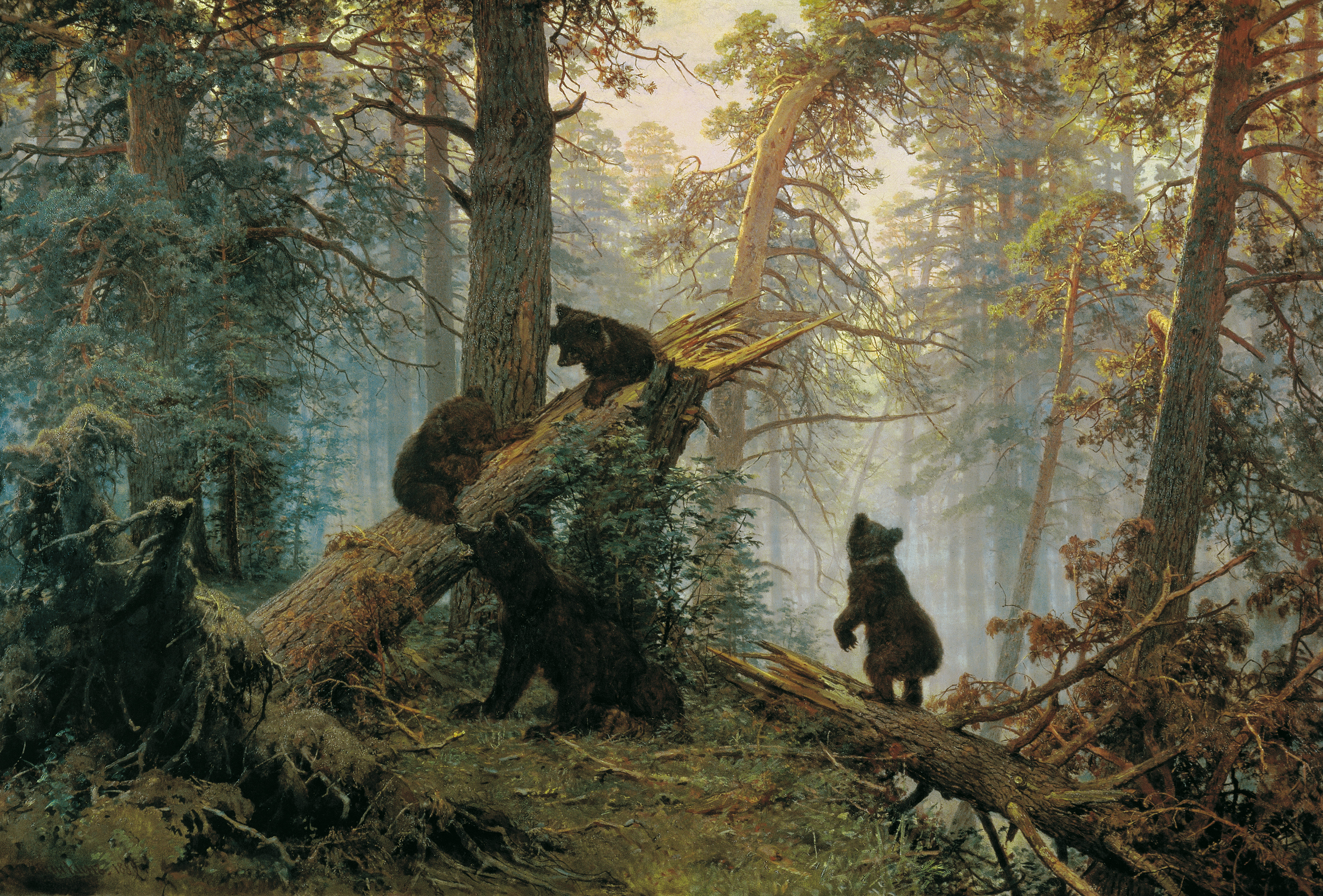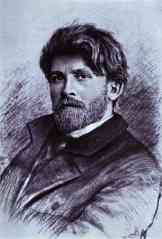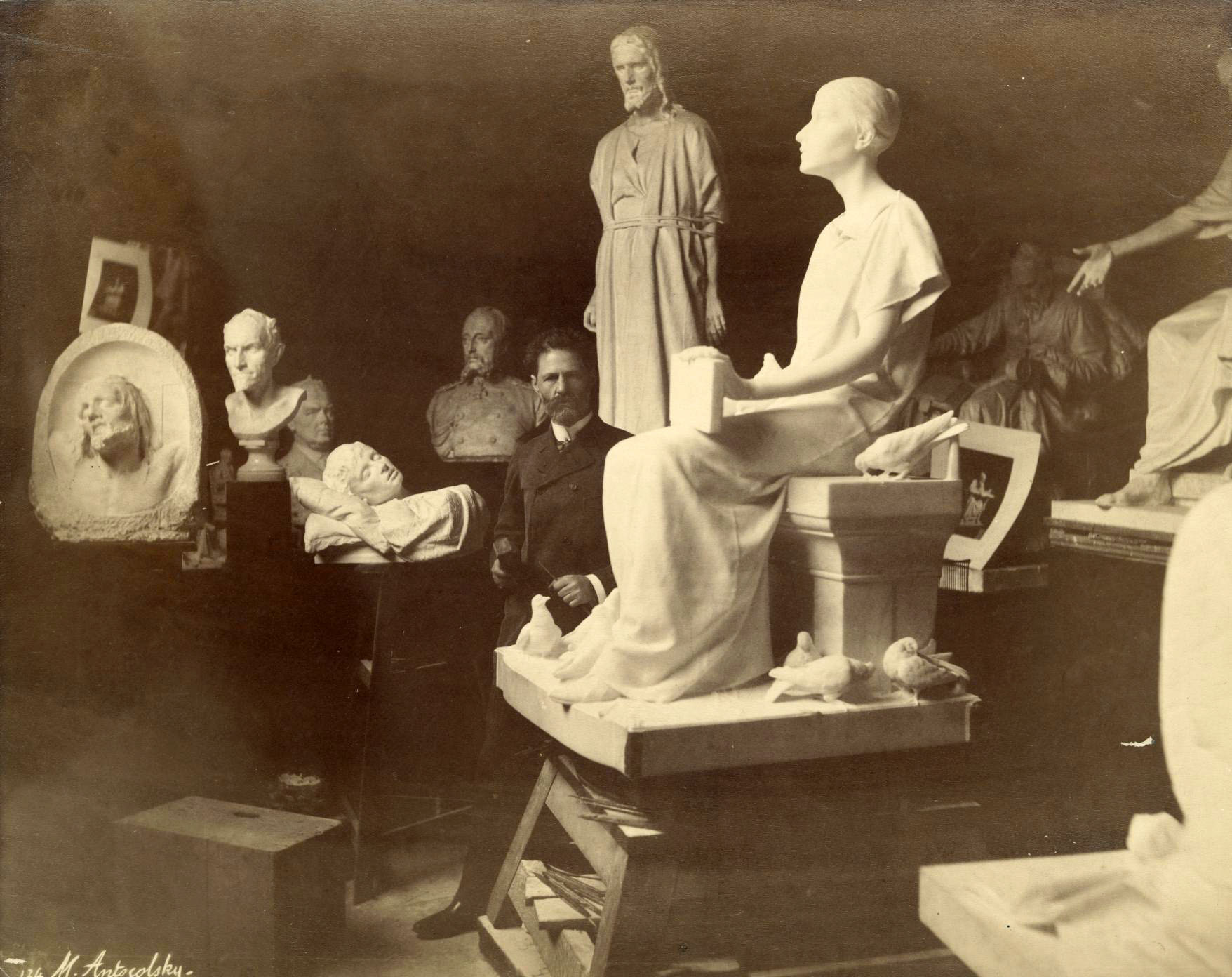|
Peredvizhniks
Peredvizhniki ( rus, Передви́жники, , pʲɪrʲɪˈdvʲiʐnʲɪkʲɪ), often called The Wanderers or The Itinerants in English, were a group of Russian realist artists who formed an artists' cooperative in protest of academic restrictions; it evolved into the ''Society for Travelling Art Exhibitions'' in 1870. History In 1863 a group of fourteen students decided to leave the Imperial Academy of Arts in Saint Petersburg. The students found the rules of the Academy constraining; the teachers were conservative and there was a strict separation between high and low art. In an effort to bring art to the people, the students formed an independent artistic society; The Petersburg Cooperative of Artists (Artel). In 1870, this organization was largely succeeded by the Association of Travelling Art Exhibits (Peredvizhniki) to give people from the provinces a chance to follow the achievements of Russian Art, and to teach people to appreciate art. The society maintained ind ... [...More Info...] [...Related Items...] OR: [Wikipedia] [Google] [Baidu] |
Ilia Efimovich Repin (1844-1930) - Volga Boatmen (1870-1873)
Ilya Yefimovich Repin (russian: Илья Ефимович Репин, translit=Il'ya Yefimovich Repin, p=ˈrʲepʲɪn); fi, Ilja Jefimovitš Repin ( – 29 September 1930) was a Russian painter, born in what is now Ukraine. He became one of the most renowned artists in Russia during the 19th century. His major works include ''Barge Haulers on the Volga'' (1873), '' Religious Procession in Kursk Province'' (1880–1883), ''Ivan the Terrible and His Son Ivan'' (1885); and ''Reply of the Zaporozhian Cossacks'' (1880–1891). He is also known for the revealing portraits he made of the leading literary and artistic figures of his time, including Mikhail Glinka, Modest Mussorgsky, Pavel Tretyakov and especially Leo Tolstoy, with whom he had a long friendship. Repin was born in Chuguyev, in Kharkov Governorate of the Russian Empire. His father had served in an Uhlan Regiment in the Russian army, and then sold horses. Repin began painting icons at age sixteen. He failed at his first e ... [...More Info...] [...Related Items...] OR: [Wikipedia] [Google] [Baidu] |
Emancipation Reform Of 1861
The emancipation reform of 1861 in Russia, also known as the Edict of Emancipation of Russia, (russian: Крестьянская реформа 1861 года, translit=Krestyanskaya reforma 1861 goda – "peasants' reform of 1861") was the first and most important of the liberal reforms enacted during the reign (1855–1881) of Emperor Alexander II of Russia. The reform effectively abolished serfdom throughout the Russian Empire. The 1861 Emancipation Manifesto proclaimed the emancipation of the serfs on private estates and of the domestic (household) serfs. By this edict more than 23 million people received their liberty.Mee, Arthur; Hammerton, J.A.; Innes, Arthur D.; Harmsworth History of the World: Volume 7', 1907, Carmelite House, London; p. 5193. Serfs gained the full rights of free citizens, including rights to marry without having to gain consent, to own property and to own a business. The Manifesto prescribed that peasants would be able to buy the land from the landlords ... [...More Info...] [...Related Items...] OR: [Wikipedia] [Google] [Baidu] |
Andrei Ryabushkin
Andrei Petrovich Ryabushkin (russian: Андре́й Петро́вич Ря́бушкин; – ) was a Russian painter. His major works were devoted to life of ordinary Russians of the 17th century. Biography Andrey Petrovich Ryabushkin was born in the village Stanichnaya sloboda, Borisoglebskiy uezd, Tambov gubernia in 1861. His father and brother were icon painters, and he started to help them from his early childhood. At 14 years old he became an orphan. A student of Moscow School of Painting, Sculpture and Architecture A. Kh. Preobrazhensky, who spent the summer in the village, happened to see the boy’s drawings and was greatly impressed by them. He started to give him lessons and helped him to enter the Moscow School of Painting, Sculpture and Architecture. Ryabushkin was one of the youngest student of the school at all times. Ryabushkin stayed for seven years (1875–82) in the Moscow School, learning from Vasily Perov and Illarion Pryanishnikov. His first large work '' ... [...More Info...] [...Related Items...] OR: [Wikipedia] [Google] [Baidu] |
Vasili Vasilyevich Vereshchagin
Vasily Vasilyevich Vereshchagin (russian: Васи́лий Васи́льевич Вереща́гин, October 26, 1842April 13, 1904), was one of the most famous Russian war artists and one of the first Russian artists to be widely recognised abroad. The graphic nature of his realist scenes led to many of them never being printed or exhibited.Kowner, '' Historical Dictionary of the Russo-Japanese War'', p. 408. Years of apprenticeship Vereshchagin was born at Cherepovets, Novgorod Governorate, Russia, in 1842 as the middle of three brothers. His father was a landowner of noble birth, while his mother was of common origin and had Tatar roots. When he was eight years old, he was sent to Tsarskoe Selo to enter the Alexander Cadet Corps. Three years later, he entered the Sea Cadet Corps at St Petersburg, making his first voyage in 1858. He served on the frigate , which sailed to Denmark, France and Egypt. Vereshchagin graduated first in his list at the naval school, but lef ... [...More Info...] [...Related Items...] OR: [Wikipedia] [Google] [Baidu] |
Mark Antokolski
Mark Matveyevich Antokolsky (russian: Марк Матве́евич Антоко́льский; 2 November 18409 July 1902) was a Russian Imperial sculptor of Lithuanian Jewish descent. Biography Mordukh Matysovich Antokolsky''Boris Schatz: The Father of Israeli Art'' Yigal Zalmona, The Israel Museum, 2006, signed letter from Paris, p.18. was born in Vilnius ( Antokol city district), Lithuania (at the time part of the Russian Empire). He studied in the Imperial Academy of Arts (1862–68) at St. Petersburg. He first began with Jewish themes, statues: "Jewish Tailor", "Nathan The Wise", "Inquisition's Attack against Jews", "The Talmudic Debate". From 1868–1870, Mark Antokolsky lived in Berlin. His statue of Ivan the Terrible (1870) was purchased for the Hermitage by Emperor Alexander II of Russia. The latter approved his work and awarded the sculptor the title of Academic. Antokolsky believed that sculpture was a social and humane ideal. In order to improve his failing hea ... [...More Info...] [...Related Items...] OR: [Wikipedia] [Google] [Baidu] |
Armenia
Armenia (), , group=pron officially the Republic of Armenia,, is a landlocked country in the Armenian Highlands of Western Asia.The UNbr>classification of world regions places Armenia in Western Asia; the CIA World Factbook , , and ''Oxford Reference Online'' also place Armenia in Asia. It is a part of the Caucasus region; and is bordered by Turkey to the west, Georgia to the north, the Lachin corridor (under a Russian peacekeeping force) and Azerbaijan to the east, and Iran and the Azerbaijani exclave of Nakhchivan to the south. Yerevan is the capital, largest city and the financial center. Armenia is a unitary, multi-party, democratic nation-state with an ancient cultural heritage. The first Armenian state of Urartu was established in 860 BC, and by the 6th century BC it was replaced by the Satrapy of Armenia. The Kingdom of Armenia reached its height under Tigranes the Great in the 1st century BC and in the year 301 became the first state in the world to adopt ... [...More Info...] [...Related Items...] OR: [Wikipedia] [Google] [Baidu] |
Latvia
Latvia ( or ; lv, Latvija ; ltg, Latveja; liv, Leţmō), officially the Republic of Latvia ( lv, Latvijas Republika, links=no, ltg, Latvejas Republika, links=no, liv, Leţmō Vabāmō, links=no), is a country in the Baltic region of Northern Europe. It is one of the Baltic states; and is bordered by Estonia to the north, Lithuania to the south, Russia to the east, Belarus to the southeast, and shares a maritime border with Sweden to the west. Latvia covers an area of , with a population of 1.9 million. The country has a temperate seasonal climate. Its capital and largest city is Riga. Latvians belong to the ethno-linguistic group of the Balts; and speak Latvian, one of the only two surviving Baltic languages. Russians are the most prominent minority in the country, at almost a quarter of the population. After centuries of Teutonic, Swedish, Polish-Lithuanian and Russian rule, which was mainly executed by the local Baltic German aristocracy, the independent R ... [...More Info...] [...Related Items...] OR: [Wikipedia] [Google] [Baidu] |
Ukraine
Ukraine ( uk, Україна, Ukraïna, ) is a country in Eastern Europe. It is the second-largest European country after Russia, which it borders to the east and northeast. Ukraine covers approximately . Prior to the ongoing Russian invasion, it was the eighth-most populous country in Europe, with a population of around 41 million people. It is also bordered by Belarus to the north; by Poland, Slovakia, and Hungary to the west; and by Romania and Moldova to the southwest; with a coastline along the Black Sea and the Sea of Azov to the south and southeast. Kyiv is the nation's capital and largest city. Ukraine's state language is Ukrainian; Russian is also widely spoken, especially in the east and south. During the Middle Ages, Ukraine was the site of early Slavic expansion and the area later became a key centre of East Slavic culture under the state of Kievan Rus', which emerged in the 9th century. The state eventually disintegrated into rival regional po ... [...More Info...] [...Related Items...] OR: [Wikipedia] [Google] [Baidu] |
Vasily Surikov
Vasily Ivanovich Surikov (Russian: Василий Иванович Суриков; 24 January 1848 – 19 March 1916) was a Russian Realist history painter. Many of his works have become familiar to the general public through their use as illustrations. Biography He was born to an old family descending from Don Cossacks that had settled in Siberia.Brief biography @ RusArtNet. His father was a Collegiate Registrar, a civil service rank that often served as postmasters. In 1854, as a result of his father being reassigned, the family moved to the village of [...More Info...] [...Related Items...] OR: [Wikipedia] [Google] [Baidu] |
The Morning Of The Streltsy Execution
''The Morning of the Streltsy Execution'' is a painting by Vasily Ivanovich Surikov, painted in 1881. It illustrates the public execution after the Streltsy's failed attempted uprising before the walls of the Kremlin. It shows the display of power the Russian government had during the late years of the 17th century. The painting can be found at the Tretyakov Gallery The State Tretyakov Gallery (russian: Государственная Третьяковская Галерея, ''Gosudarstvennaya Tretyâkovskaya Galereya''; abbreviated ГТГ, ''GTG'') is an art gallery in Moscow, Russia, which is considered th ... in Moscow. References {{DEFAULTSORT:Morning of the Streltsy Execution 1881 paintings Collections of the Tretyakov Gallery Cultural depictions of Peter the Great ... [...More Info...] [...Related Items...] OR: [Wikipedia] [Google] [Baidu] |
Ilya Repin
Ilya Yefimovich Repin (russian: Илья Ефимович Репин, translit=Il'ya Yefimovich Repin, p=ˈrʲepʲɪn); fi, Ilja Jefimovitš Repin ( – 29 September 1930) was a Russian painter, born in what is now Ukraine. He became one of the most renowned artists in Russia during the 19th century. His major works include ''Barge Haulers on the Volga'' (1873), '' Religious Procession in Kursk Province'' (1880–1883), ''Ivan the Terrible and His Son Ivan'' (1885); and ''Reply of the Zaporozhian Cossacks'' (1880–1891). He is also known for the revealing portraits he made of the leading literary and artistic figures of his time, including Mikhail Glinka, Modest Mussorgsky, Pavel Tretyakov and especially Leo Tolstoy, with whom he had a long friendship. Repin was born in Chuguyev, in Kharkov Governorate of the Russian Empire. His father had served in an Uhlan Regiment in the Russian army, and then sold horses. Repin began painting icons at age sixteen. He failed at his first ... [...More Info...] [...Related Items...] OR: [Wikipedia] [Google] [Baidu] |
They Did Not Expect Him
''They Did Not Expect Him'' is a painting by Russian realist artist Ilya Repin made between 1884 and 1888. It depicts the return of a narodnik from exile and his family's reaction. The painting is part of Repin's "Narodniki" series, which includes four other artworks. Repin began working on early versions of the canvas in 1884, at his country house in Martyshkino. He displayed it the same year in the 12th travelling exhibition of the Peredvizhniki, a group of Russian realist artists who travelled around Russia to host art exhibitions, first in Saint-Petersburg and then in other cities of Russia. It was purchased by Pavel Tretyakov in 1885 for display in his gallery. However, Repin continued to work on the painting after it was purchased, making several changes in 1885, 1887 and 1888, primarily to the face of the man entering the room. Russian artist and art critic Igor Grabar wrote that the paintings ''They Did Not Expect Him'' and ''Ivan the Terrible and His Son Ivan'' beca ... [...More Info...] [...Related Items...] OR: [Wikipedia] [Google] [Baidu] |






.jpg)
